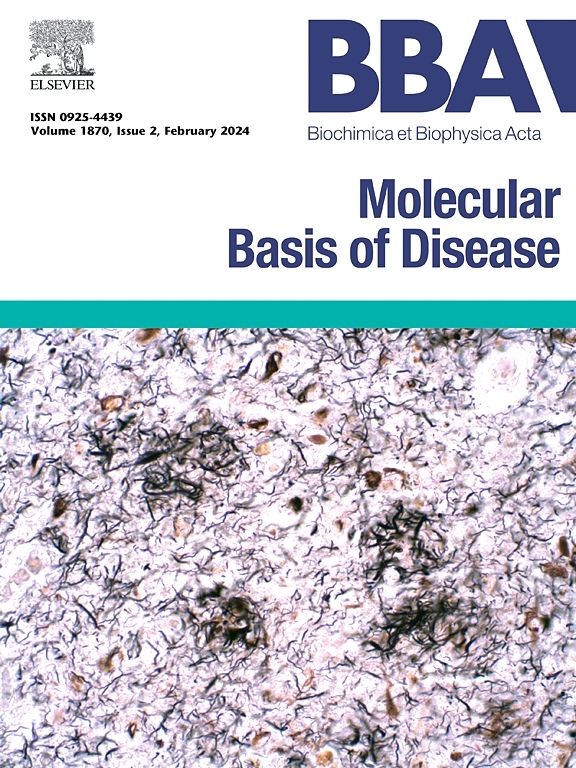Down-regulating HDAC2-LTA4H pathway ameliorates renal ischemia-reperfusion injury
IF 4.2
2区 生物学
Q2 BIOCHEMISTRY & MOLECULAR BIOLOGY
Biochimica et biophysica acta. Molecular basis of disease
Pub Date : 2025-05-03
DOI:10.1016/j.bbadis.2025.167889
引用次数: 0
Abstract
Background
The activation of histone deacetylase 2 (HDAC2) is the main pathogenesis of acute kidney injury (AKI), one of the leading causes of end-stage kidney disease. However, the regulatory role of HDAC2 upregulation on inflammation in AKI is still unclear.
Results
In this study, we found that treatment with HDAC2 inhibitor BRD6688 could mitigate the degree of mesangial sclerosis, interstitial infiltration and tubular atrophy, reduce the concentration of blood urea nitrogen (BUN) and serum creatinine (Scr), improve the proliferation, anti-apoptotic, anti-oxidative stress and angiogenesis effects of renal cells. Our results mainly indicated that renal HDAC2 activity was increased by casein kinase 2 (CK2) in renal ischemia reperfusion (I/R) models, and HDAC2 genetic ablation in HREpiC cells suppressed the leukotriene B4 (LTB4) production. Renal leukotriene A4 hydrolase (LTA4H) activity was increased in AKI mice in a HDAC2-dependent manner. LTB4 could induce monocytes to differentiate into M1 macrophages, while BRD6688 could suppress this effect and force the M1 macrophages polarize to M2 macrophages.
Conclusion
Inhibition of HDAC2 activities by BRD6688 could suppress the progression of renal I/R injury through the regulation of LTA4H and macrophage polarization.
下调HDAC2-LTA4H通路可改善肾缺血再灌注损伤
组蛋白去乙酰化酶2 (HDAC2)的激活是急性肾损伤(AKI)的主要发病机制,是终末期肾脏疾病的主要原因之一。然而,HDAC2上调对AKI炎症的调节作用尚不清楚。结果本研究发现,HDAC2抑制剂BRD6688可减轻肾系膜硬化、间质浸润和肾小管萎缩程度,降低血尿素氮(BUN)和血清肌酐(Scr)浓度,提高肾细胞增殖、抗凋亡、抗氧化应激和血管生成作用。我们的研究结果主要表明,在肾缺血再灌注(I/R)模型中,酪蛋白激酶2 (CK2)增加了肾HDAC2活性,HREpiC细胞中HDAC2基因消融抑制了白三烯B4 (LTB4)的产生。肾白三烯A4水解酶(LTA4H)活性在AKI小鼠中以hdac2依赖性方式升高。LTB4可以诱导单核细胞分化为M1巨噬细胞,而BRD6688可以抑制这一作用,迫使M1巨噬细胞极化为M2巨噬细胞。结论BRD6688抑制HDAC2活性可通过调控LTA4H和巨噬细胞极化抑制肾I/R损伤的进展。
本文章由计算机程序翻译,如有差异,请以英文原文为准。
求助全文
约1分钟内获得全文
求助全文
来源期刊
CiteScore
12.30
自引率
0.00%
发文量
218
审稿时长
32 days
期刊介绍:
BBA Molecular Basis of Disease addresses the biochemistry and molecular genetics of disease processes and models of human disease. This journal covers aspects of aging, cancer, metabolic-, neurological-, and immunological-based disease. Manuscripts focused on using animal models to elucidate biochemical and mechanistic insight in each of these conditions, are particularly encouraged. Manuscripts should emphasize the underlying mechanisms of disease pathways and provide novel contributions to the understanding and/or treatment of these disorders. Highly descriptive and method development submissions may be declined without full review. The submission of uninvited reviews to BBA - Molecular Basis of Disease is strongly discouraged, and any such uninvited review should be accompanied by a coverletter outlining the compelling reasons why the review should be considered.

 求助内容:
求助内容: 应助结果提醒方式:
应助结果提醒方式:


